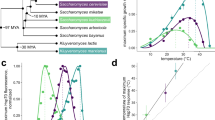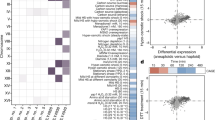Abstract
Hydrostatic pressure is one of the physical factors affecting cellular physiology. Hydrostatic pressure of a few hundred MPa decreases the viability of yeast cells, and pressure of a few tens MPa decreases the growth rate. To understand the effect of hydrostatic pressure, we employed yeast DNA microarrays and analyzed genome-wide gene-expression levels after the pressure treatment with 180 MPa (immediate) at 4°C and recovery incubation for 1 h and 40 MPa (16 h) at 4°C and recovery incubation for 1 h. The transcription of genes involved in energy metabolism, cell defense, and protein metabolism was significantly induced by the pressure treatment. Genome-wide expression profiles suggested that high pressure caused damage to cellular organelles, since the induced gene products were localized in the membrane structure and/or cellular organelles. Hierarchical clustering analysis suggested that the damage caused by the pressure was similar to that caused by detergents, oils, and freezing/thawing. We also estimated the contribution of induced genes to barotolerance using some strains that have the deletion in the corresponding genes.




Similar content being viewed by others
References
Abe F, Horikoshi K (1995) Hydrostatic pressure promotes the acidification of vacuoles in Saccharomyces cerevisiae. FEMS Microbiol Lett 130:307–312
Abe F, Horikoshi K (2000) Tryptophan permease gene TAT2 confers high-pressure growth in Saccharomyces cerevisiae. Mol Cell Biol 208:093–102
Eisen MB, Spellman PT, Brown PO, Botstein D (1998) Cluster analysis and display of genome-wide expression patterns. Proc Natl Acad Sci USA 95:14863–8
Hamada K, Nakatomi Y, Shimada S (1992) Direct induction of tetraploids or homozygous diploids in the industrial yeast Saccharomyces cerevisiae by hydrostatic pressure. Curr Genet 22:371–376
Hayashi R (1989) Use of high pressure to food processing and preservation. In: Hayashi R (ed) Use of high pressure in food. Sanei, Kyoto, Japan, pp 1–30
Iwahashi H, Obuchi K, Kaul SC, Komatsu Y (1991) Induction of barotolerance by heat shock treatment in yeast. FEMS Microbiol Lett 80:325–328
Iwahashi H, Obuchi K, Fujii S, Komatsu Y (1997a) Barotolerance is dependent on both trehalose and heat shock protein 104 but is essentially different from thermotolerance in Saccharomyces cerevisiae. Lett Appl Microbiol 25:43–47
Iwahashi H, Obuchi K, Fujii S, Komatsu Y (1997b) Effect of temperature on the role of Hsp104 and trehalose in barotolerance of Saccharomyces cerevisiae. FEBS Lett 416:1–5
Iwahashi H, Nwaka S, Obuchi K (2000) Evidence for contribution of neutral trehalase in barotolerance of Saccharomyces cerevisiae. Appl Environ Microbiol 66:5182–5185
Iwahashi H, Nwaka S, Obuchi K (2001) Contribution of Hsc70 to barotolerance in the yeast Saccharomyces cerevisiae. Extremophiles 5:417–421
Kaiser CA, Gimeno RE, Shaywitz DA (1997) Protein secretion, membrane biogenesis, and endocytosis. In: Pringle JR, Broach JR, Jones EW (eds) The molecular and cellular biology of the yeast Saccharomytces cerevisiae. Cold Spring Harbor Press, New York, pp 91–228
Kobori H, Sato M, Tameike A, Hamada K, Shimada S, Osumi M (1995) Ultrastructural effects of pressure stress to the nucleus in Saccharomyces cerevisiae: a study by immunoelectron microscopy using frozen thin sections. FEMS Microbiol Lett 132:253–258
Kohrer, K, Domdey H (1990) Guide to yeast genetics and molecular biology. Methods Enzymol 194:398–401
Momose Y, Iwahashi H (2001) Bioassay of cadmium using a DNA microarray: genome-wide expression patterns of Saccharomyces cerevisiae response to cadmium. Environ Toxicol Chem 20:2353–2360
Murata Y, Momose Y, Hasegawa M, Iwahashi H, Komatsu Y (2002) Cluster analysis and display of genome-wide expression profiles in dimethyl sulfoxide treatment. Chem-Bio Informatics J 2:18–31
Ohmine K, Ota J, Ueda M, Ueno S, Yoshida K, Yamashita Y, Kirito K, Imagawa S, Nakamura Y, Saito K, Akutsu M, Mitani K, Kano Y, Komatsu N, Ozawa K, Mano H (2001) Characterization of stage progression in chronic myeloid leukemia by DNA microarray with purified hematopoietic stem cells. Oncogene 20:8249–8257
Piper PW (1993) Molecular events associated with acquisition of heat tolerance by the yeast Saccharomyces cerevisiae. FEMS Microbiol Rev 11:339–355
Tamura K, Miyashita M, Iwahashi H (1998) Stress tolerance of pressure-shocked Saccharomyces cerevisiae. Biotechnol Lett 20:1167–1169
Author information
Authors and Affiliations
Corresponding author
Additional information
An erratum to this article can be found at http://dx.doi.org/10.1007/s00792-003-0359-y
Communicated by K. Horikoshi
Rights and permissions
About this article
Cite this article
Iwahashi, H., Shimizu, H., Odani, M. et al. Piezophysiology of genome wide gene expression levels in the yeast Saccharomyces cerevisiae . Extremophiles 7, 291–298 (2003). https://doi.org/10.1007/s00792-003-0322-y
Received:
Accepted:
Published:
Issue Date:
DOI: https://doi.org/10.1007/s00792-003-0322-y




